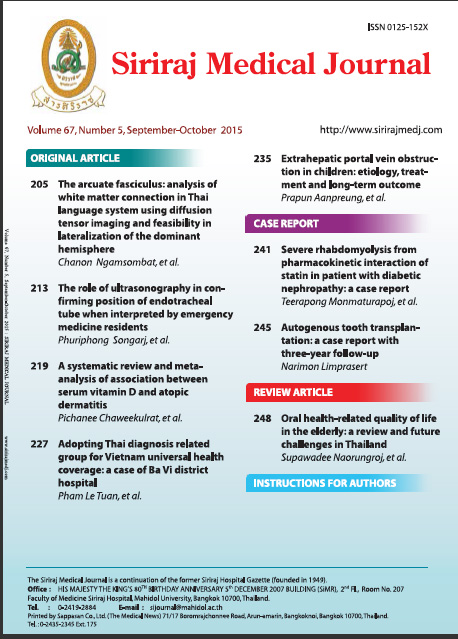Extrahepatic portal vein obstruction in children: Etiology, treatment and long-term outcome
Abstract
Objective:Extrahepatic portal vein obstruction (EHPVO) is a common cause of portal hypertension in children. Informative data about this disease in Thai children is still limited. The objective is to study etiology, clinical presentation, investigation, treatment, result and long-term outcome.
Material and Methods:The medical records of patients aged less than 15 years with diagnosis of EHPVO at Siriraj Hospital from 1993 to 2013 were retrospectively analyzed.
Results:There were 22 children(13 males and 9 females) with median age at diagnosis 5.1 years. The etiology was idiopathic in more than 50%. The patients had umbilical vein catheterization at least 27.2%.The presenting symptoms were splenomegaly 54.5% and upper gastrointestinal bleeding 45.5%. Doppler ultrasonography showed positive results in 52.6%. Initial endoscopic finding showed esophageal varices (EV) grade I 27.3%, grade II 36.3%, grade III 31.8%,and gastric varices (GV) 4.6%.The indications for endoscopic interventions were primary prophylaxis 30%, secondary prophylaxis 40% and stopping GI bleeding 30%.The interventions included endoscopicsclerotherapy (EST) in 6cases, esophageal variceal ligation (EVL)in 6cases, both in7 cases and glue injection in 1 case.Rebleedingoccurred in 50% of secondary prophylaxis and bleeding groups, but none inthe primary prophylaxis group. Patients were followed up for a median of 5.3 years. For long term follow-up, massive splenomegaly andhypersplenism were the major concerns. Surgical treatment included splenectomy (3 cases) and distal splenorenal shunt (1 case).None of the patients died from complications.
Conclusion:The etiology ofEHPVO is unknown in the majority of patients. SCT and EVL had success to control and prevent varicealbleeding and eradicate varices. There is an unsettled issue about management of EHPVO after control acute bleeding. Currently, Meso-Rex bypass and distal splenorenal shunt are proposed to be the recommended treatment for suitable cases with reported success in both eradicating varices and control hypersplenism albeit preserving the spleen.
Keywords: Portal hypertension, hypersplenism. sclerotherapy, esophageal banding
Downloads
Published
How to Cite
Issue
Section
License
Authors who publish with this journal agree to the following conditions:
Copyright Transfer
In submitting a manuscript, the authors acknowledge that the work will become the copyrighted property of Siriraj Medical Journal upon publication.
License
Articles are licensed under a Creative Commons Attribution-NonCommercial-NoDerivatives 4.0 International License (CC BY-NC-ND 4.0). This license allows for the sharing of the work for non-commercial purposes with proper attribution to the authors and the journal. However, it does not permit modifications or the creation of derivative works.
Sharing and Access
Authors are encouraged to share their article on their personal or institutional websites and through other non-commercial platforms. Doing so can increase readership and citations.











